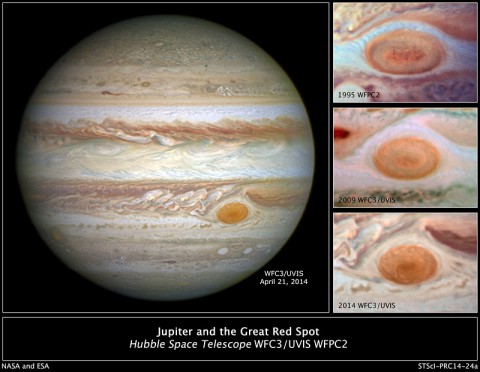Written by Whitney Clavin
NASA’s Jet Propulsion Laboratory
 Pasadena, CA – Jupiter’s trademark Great Red Spot — a swirling storm feature larger than Earth — has shrunk to its smallest size ever measured.
Pasadena, CA – Jupiter’s trademark Great Red Spot — a swirling storm feature larger than Earth — has shrunk to its smallest size ever measured.
According to Amy Simon of NASA’s Goddard Space Flight Center in Greenbelt, Maryland, recent NASA Hubble Space Telescope observations confirm the Great Red Spot now is approximately 10,250 miles (16,500 kilometers) across. Astronomers have followed this downsizing since the 1930s.

NASA’s Voyager 1 and Voyager 2 flybys of Jupiter in 1979 measured the storm to be 14,500 miles (23,300 kilometers) across.
In the comparison images, one Hubble photo was taken in 1995 by the Hubble’s Wide Field and Planetary Camera 2 (WFPC2) when the long axis of the Great Red Spot was estimated to be 13,020 miles (20,950 kilometers) across.
This camera was developed and built by NASA’s Jet Propulsion Laboratory in Pasadena, California, and corrected the telescope’s initial blurry vision. In a 2009 photo, after WFPC2 had been replaced by the Wide Field Camera 3 (WFC3), the storm was measured at 11,130 miles (17,910 kilometers) across.
Beginning in 2012, amateur observations revealed a noticeable increase in the rate at which the spot is shrinking — by 580 miles (930 kilometers) per year — changing its shape from an oval to a circle.
“In our new observations it is apparent that very small eddies are feeding into the storm,” said Simon. “We hypothesized that these may be responsible for the accelerated change by altering the internal dynamics and energy of the Great Red Spot.”
Simon’s team plans to study the motions of the small eddies and also the internal dynamics of the storm to determine whether these eddies can feed or sap momentum entering the upwelling vortex, resulting in this yet unexplained shrinkage.
The Hubble Space Telescope is a project of international cooperation between NASA and the European Space Agency. NASA’s Goddard Space Flight Center in Greenbelt, Maryland, manages the telescope. The Space Telescope Science Institute (STScI) in Baltimore conducts Hubble science operations. STScI is operated for NASA by the Association of Universities for Research in Astronomy, Inc., in Washington.
For more information about the WFPC2, visit:
http://go.nasa.gov/1kyiuSL
For more information about NASA’s Hubble Space Telescope, visit these sites:
http://www.nasa.gov/hubble
http://hubblesite.org/
The Voyager spacecraft were built and continue to be operated by NASA’s Jet Propulsion Laboratory in Pasadena, California. Caltech manages JPL for NASA. The Voyager missions are a part of NASA’s Heliophysics System Observatory, sponsored by the Heliophysics Division of the Science Mission Directorate at NASA Headquarters in Washington.
For more information about Voyager, visit these sites:
http://www.nasa.gov/voyager
http://voyager.jpl.nasa.gov


